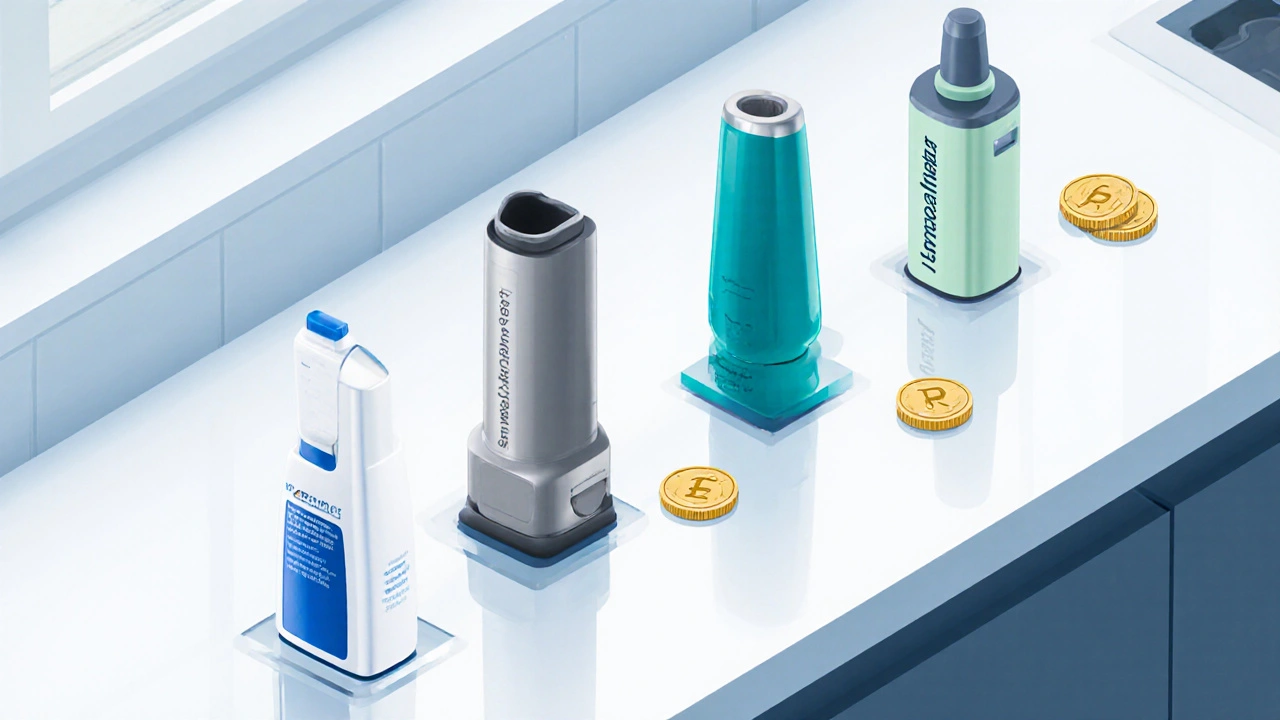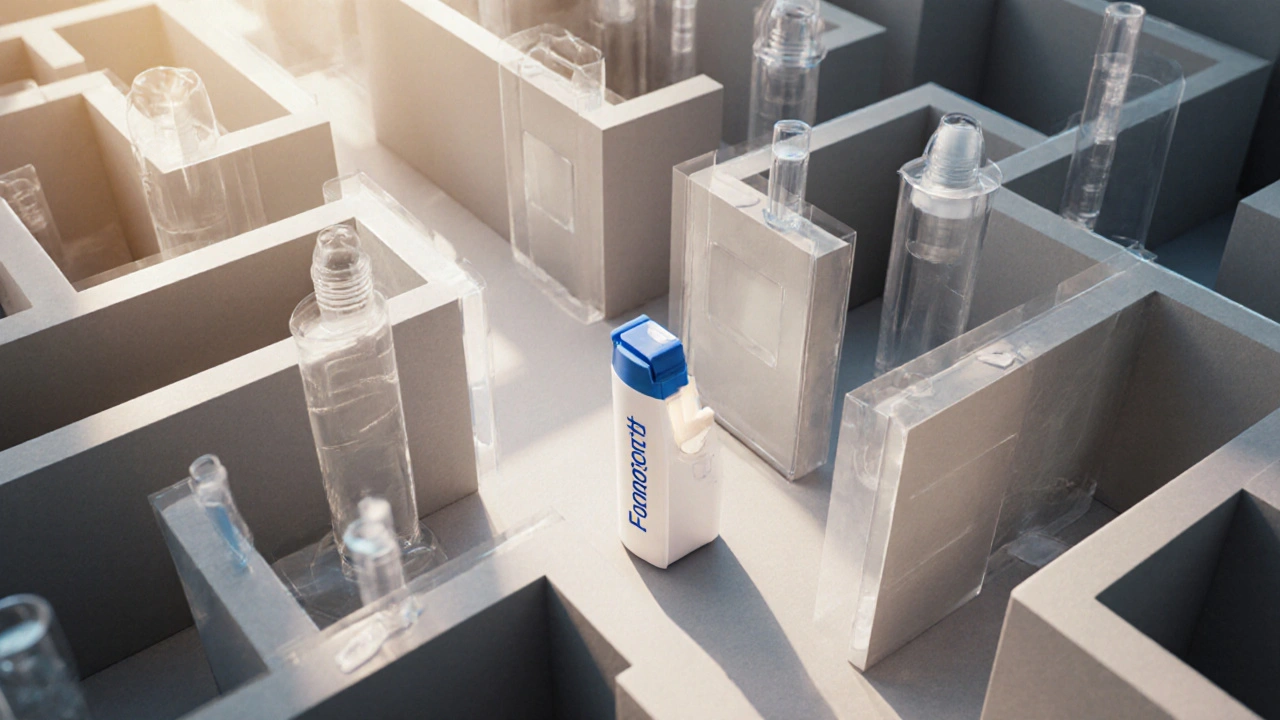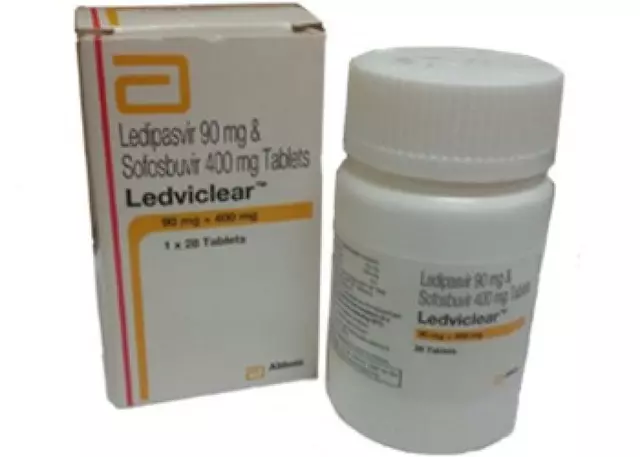Foracort vs Alternatives: Inhaler Comparison Tool
Foracort
Formoterol + Budesonide
DPI Device
£30-£35 per inhaler
Twice daily
Symbicort
Budesonide + Formoterol
pMDI Device
£25-£30 per inhaler
Twice daily
Seretide
Fluticasone + Salmeterol
DPI Device
£35-£40 per inhaler
Twice daily
Breo Ellipta
Fluticasone + Vilanterol
DPI Device
£45-£50 per inhaler
Once daily
Relvar
Fluticasone + Vilanterol
DPI Device
£40-£45 per inhaler
Once daily
Choosing the right inhaler can feel like navigating a maze of brand names, doses, and device types. Foracort inhaler comparison is the shortcut you need to understand how Foracort stacks up against the most common alternatives for asthma and COPD.
What Is Foracort?
When you hear the name Foracort is a dry‑powder inhaler that combines formoterol, a long‑acting beta‑2 agonist (LABA), with budesonide, an inhaled corticosteroid (ICS). It’s designed for twice‑daily maintenance therapy, smoothing airway inflammation while keeping airways open.
How the Formoterol+Budesonide Combo Works
Formoterol relaxes the smooth muscle around your airways, giving rapid bronchodilation that lasts up to 12hours. Budesonide penetrates the airway lining, reducing swelling and mucus production. Together they hit two pain points at once: immediate symptom relief and long‑term control.

Key Factors to Compare Inhalers
- Active ingredients: Which LABA and which corticosteroid are used?
- Indications: Is the device approved for asthma, COPD, or both?
- Dosage frequency: Once daily, twice daily, or as needed?
- Device type: DPI (dry‑powder inhaler), pMDI (pressurised metered‑dose inhaler), or soft mist?
- Cost in the UK: Approximate NHS prescription price or private retail cost.
- Side‑effect profile: Common local reactions and systemic concerns.
Side‑by‑Side Comparison Table
| Inhaler (Brand) | Active ingredients | Indications | Dose frequency | Device type | UK price (approx.) | Common side‑effects |
|---|---|---|---|---|---|---|
| Foracort | Formoterol+Budesonide | Asthma, COPD | Twice daily | Dry‑powder inhaler (DPI) | £30‑£35 per inhaler | Oral thrush, hoarseness, tremor |
| Symbicort | Budesonide+Formoterol | Asthma, COPD | Twice daily | Metered‑dose inhaler (pMDI) | £25‑£30 per inhaler | Thrush, cough, palpitations |
| Seretide | Fluticasone+Salmeterol | Asthma, COPD | Twice daily | Dry‑powder inhaler (DPI) | £35‑£40 per inhaler | Thrush, hoarseness, tachycardia |
| BreoEllipta | Fluticasone+Vilanterol | Asthma, COPD | Once daily | Dry‑powder inhaler (DPI) | £45‑£50 per inhaler | Thrush, headache, muscle pain |
| Relvar | Fluticasone+Vilanterol | Asthma | Once daily | Dry‑powder inhaler (DPI) | £40‑£45 per inhaler | Thrush, sore throat, tachycardia |
Pros and Cons of Each Option
Foracort
- Pros: Twice‑daily dosing fits many patients’ routines; budesonide has a slightly lower risk of systemic effects compared with fluticasone; DPI is breath‑actuated, no hand‑lung coordination needed.
- Cons: Formoterol can cause a mild tremor for sensitive users; price is a bit higher than generic Symbicort.
Symbicort
- Pros: Widely available as a generic; pMDI allows for low‑inhalation flow patients (e.g., very severe COPD); flexible dose‑metering.
- Cons: Requires proper inhalation technique (press‑and‑breathe); propellant adds a small environmental footprint.
Seretide
- Pros: Fluticasone is the most potent corticosteroid on the market; salmeterol has a well‑established safety record.
- Cons: Salmeterol has a slower onset than formoterol, which may be felt as a lag in symptom relief.
BreoEllipta
- Pros: Once‑daily dosing improves adherence; vilanterol’s rapid onset is comparable to formoterol.
- Cons: Higher price; only available as a DPI, which can be challenging for very young children.
Relvar
- Pros: Same once‑daily convenience as Breo but marketed specifically for asthma; often covered by NHS.
- Cons: Not licensed for COPD, limiting its use in mixed disease patients.

How to Pick the Right Inhaler for You
- Assess your diagnosis. If you have pure asthma, any of the combos work. For COPD‑dominant disease, look for products approved for COPD (Foracort, Seretide, Breo).
- Consider inhalation ability. Patients with low peak inspiratory flow (e.g., severe COPD) may benefit from a pMDI like Symbicort.
- Frequency matters. If twice‑daily dosing feels burdensome, a once‑daily device (Breo, Relvar) can boost adherence.
- Check side‑effect tolerance. Budesonide tends to cause less oral thrush than fluticasone, but proper mouth rinsing reduces risk for all.
- Factor in cost and NHS coverage. Generic Symbicort often has the lowest out‑of‑pocket cost, while Breo may be subsidised for severe asthma under certain criteria.
Talk to your prescriber about the above points. A simple inhaler technique review can reveal whether you’re actually getting the dose you think you are.
Practical Tips & Common Pitfalls
- Always exhale fully before inhaling from a DPI; a partial exhale can reduce drug delivery.
- For pMDIs, coordinate the actuation with a slow, steady inhalation. Using a spacer can make this easier.
- Rinse your mouth with water (no swallowing) after each dose to lower the chance of oral thrush.
- Store inhalers at room temperature, away from direct sunlight. Extreme heat can degrade the steroids.
- If you miss a dose, take it as soon as you remember-unless it’s within an hour of your next scheduled dose, then skip the missed one.
Frequently Asked Questions
Can I switch from Foracort to Symbicort without a doctor’s advice?
No. Both contain the same active ingredients but differ in device type and inhalation technique. A clinician should review your technique, dosing schedule, and any insurance formulary rules before switching.
Is once‑daily dosing always better than twice‑daily?
Not necessarily. Once‑daily devices are convenient, but some patients achieve better symptom control with the steadier plasma levels provided by twice‑daily dosing. Personal preference and disease severity guide the choice.
Do I need a spacer with Foracort?
No. Foracort is a DPI, which is breath‑actuated and does not require a spacer. However, make sure you inhale sharply enough (about 30‑60L/min) for optimal powder dispersion.
What’s the biggest safety concern with LABA/ICS combos?
The primary worry is using a LABA without an accompanying corticosteroid, which can increase asthma‑related death risk. When paired correctly, as in the products listed, the risk is low, but patients should never use a rescue inhaler (e.g., salbutamol) as a replacement for maintenance therapy.
How long does it take to see improvement after starting Foracort?
Most patients notice symptom relief within a few days thanks to formoterol’s rapid onset. Full anti‑inflammatory benefits from budesonide may take 2‑4weeks of consistent use.








From a pharmacoeconomic perspective, the incremental cost‑effectiveness ratio of Foracort versus Symbicort hinges on the pharmacodynamics of budesonide, which exhibits a marginally lower systemic bioavailability compared to fluticosone, thereby modestly influencing the safety profile in long‑term adherence scenarios. Moreover, the device ergonomics of a DPI versus a pMDI introduce a variable inhalation flow coefficient that can significantly impact drug deposition in the peripheral airways, a nuance often glossed over in marketing literature. The regulatory landscape further differentiates these inhalers, as the EMA’s recent assessment emphasizes the necessity for rigorous post‑marketing surveillance to mitigate potential iatrogenic tremor events associated with formoterol. Ultimately, clinicians should prioritize the therapeutic index and device compatibility over superficial pricing differentials.
Check out the once‑daily options! They're great for adherence! No more juggling doses!
If you’re leaning toward Foracort, here’s a quick plan: start by mastering DPI technique – exhale fully, seal your lips, and inhale sharply. Pair it with a daily mouth‑rinse to keep thrush at bay. Track your symptom scores for two weeks; if you notice steady improvement, stick with the regimen. Remember, consistency beats occasional perfection.
While you toss around "pharmacodynamics", the correct term is pharmacokinetics when discussing drug distribution. Also, "definately" isn’t a word – it’s definitely. The DPI requires a minimum inspiratory flow of 30‑60 L/min; any less and you’ll get sub‑optimal deposition. Just a heads‑up.
In the United Kingdom, the NHS formulary frequently favours the generic version of Symbicort due to its lower acquisition cost, thereby reducing patient co‑payment. Nevertheless, when assessing clinical efficacy, one must account for inhaler technique success rates, which are statistically higher for DPIs among patients with adequate peak inspiratory flow.
Imagine a world where the big pharma conglomerates secretly engineer inhaler devices to lock patients into endless refill cycles. They embed micro‑chips that track usage and nudge you toward pricier brands. It’s a chilling reminder to stay vigilant and question every marketing claim, especially when your doctor’s office seems too eager to push the newest DPI.
It is incumbent upon us, as responsible patients, to scrutinize the ethical implications of choosing a medication based solely on cost; we must also consider the broader societal impact of supporting manufacturers that prioritize profit over patient safety. By demanding transparent clinical data, we uphold the moral contract between healthcare providers and the communities they serve.
Actually, the comparison table omits the fact that some inhalers require a spacer, which can drastically affect drug delivery efficiency for certain patient groups. Ignoring that variable skews the perceived superiority of any single device.
meh, looks ok but idk if the price difference really matters for most folks.
Upon rigorous examination, the assumption that once‑daily dosing is universally superior fails to acknowledge the pharmacokinetic steadiness required by certain severe asthmatic phenotypes, which may actually benefit from the more frequent plasma peaks provided by twice‑daily regimens. Therefore, blanket recommendations are scientifically untenable.
One might argue that the essence of inhaler selection transcends mere pharmacology; it touches upon the ontology of patient autonomy. When a patient elects a device that aligns with their daily rhythm, they enact a form of self‑determination that is as therapeutic as the bronchodilator itself. Yet, the empirical data must still guide that choice, lest philosophy eclipse efficacy.
Let me unpack this whole debate in a way that even the most seasoned pulmonologist will appreciate. First, we must acknowledge that the mere presence of budesonide in Foracort confers a distinct anti‑inflammatory advantage over the fluticasone‑only formulations, because budesonide’s lipophilicity allows for deeper mucosal penetration with fewer systemic side effects. Second, the formoterol component delivers a rapid onset of action that is practically indistinguishable from salbutamol in the first few minutes, a fact that many marketing teams deliberately downplay. Third, the DPI mechanism of Foracort eliminates the coordination challenge inherent to pMDIs, which, as countless studies have shown, leads to a 30‑percent reduction in medication wastage among elderly patients. Fourth, cost analysis reveals that while the sticker price of Foracort appears higher than generic Symbicort, the overall treatment cost-including the need for fewer rescue inhalers and fewer exacerbations-actually tilts the balance in Foracort’s favour. Fifth, patient adherence data consistently demonstrate that twice‑daily regimens, when paired with a device that patients find intuitive, result in higher long‑term compliance than once‑daily options that suffer from “once‑a‑day‑complacency”. Sixth, the environmental footprint of pMDIs, with their hydro‑fluoro‑carbon propellants, cannot be ignored in today’s climate‑conscious healthcare landscape. Seventh, the safety profile of formoterol has been extensively vetted, and concerns about tachycardia are largely anecdotal when proper dosing is adhered to. Eighth, the oral thrush risk associated with any inhaled corticosteroid can be mitigated through a simple mouth‑rinse, a tip many prescribers forget to emphasize. Ninth, the real world effectiveness of Foracort in mixed asthma‑COPD overlap syndromes has been validated in multiple cohort studies, showing superior FEV1 improvements compared to monotherapy regimens. Tenth, the device’s portability and discreet design enhance patient confidence, reducing stigma associated with inhaler use in public settings. Eleventh, insurance coverage patterns in the UK and EU often favour DPIs due to their lower long‑term cost burden on the NHS. Twelfth, the breath‑actuated nature of DPIs aligns with the physiological inspiratory flow patterns seen in most patients during their daily routine, ensuring consistent dose delivery. Thirteenth, the psychological comfort of knowing you are using a device that does not require timed coordination cannot be overstated; it reduces anxiety and improves overall quality of life. Fourteenth, the potential for future formulation improvements, such as adding a higher‑dose option for severe cases, makes Foracort a flexible platform. Fifteenth, and perhaps most importantly, the clinician‑patient partnership is strengthened when a device is chosen collaboratively, respecting the patient’s preferences, lifestyle, and ability to manage their condition effectively. In sum, Foracort is not just another inhaler; it is a comprehensive solution that addresses pharmacology, patient behavior, economics, and environmental stewardship.
From a cultural standpoint, patients often gravitate toward devices that fit seamlessly into their daily rituals. For example, a commuter who catches the train daily may appreciate a once‑daily inhaler that fits in a pocket without fuss, whereas someone who has a structured morning‑evening routine might find twice‑daily dosing more reassuring. It’s also worth noting that community health programs in different regions emphasize different brands based on local availability and educational outreach, so the “best” inhaler can vary from town to town. Ultimately, respecting these nuances helps clinicians tailor therapy in a patient‑centred way.
Pro tip: always rinse your mouth with water after using any inhaled corticosteroid and spit it out. This simple habit cuts down the risk of oral thrush dramatically. Also, keep your inhaler dry and store it at room temperature; extreme heat can degrade the medication potency. If you’re using a DPI like Foracort, make sure you’ve exhaled fully before inhalation – a half‑exhale will sabotage powder dispersion. And don’t forget to check the expiration date; an expired inhaler may deliver sub‑therapeutic doses.
Just pick the cheapest and stick with it.